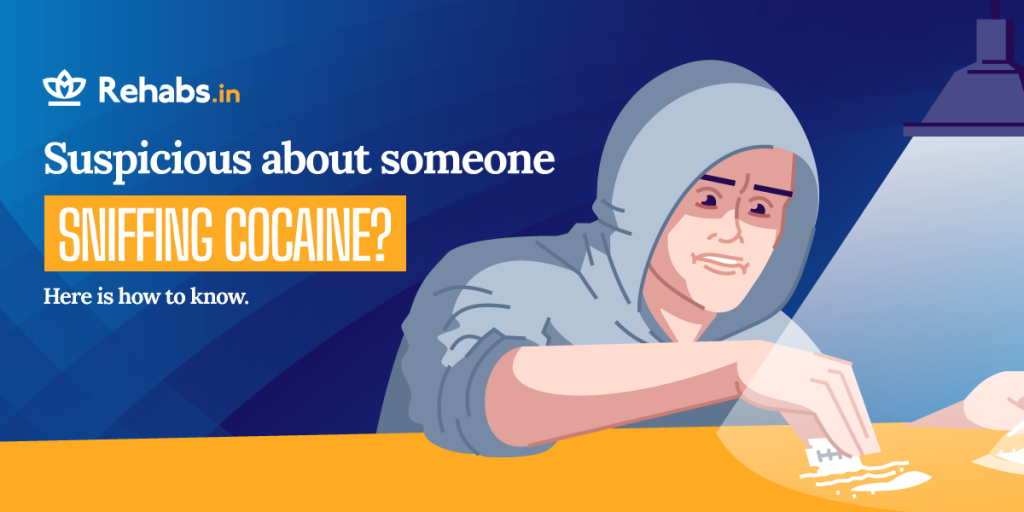How to tell if someone is sniffing cocaine?

Cocaine is an illicit, powerful stimulant drug. Repeated abuse of cocaine leads one to cocaine addiction. The risk to physical and mental health is high in this case.
Most people use cocaine for the euphoric rush in the brain. If a person snorts, smokes, or injects cocaine – the level of dopamine and euphoria increases.
There are ways you can sense if someone is sniffing cocaine. After sniffing cocaine, the person would exhilarate and are often found to be talkative, confident, and energetic. Physical, psychological, behavioural, and medical changes are a big lead to track cocaine abuse.
In this blog, you will be tracing the different methods of cocaine abuse, its effects, and the signs one exhibits.
Signs and Effects of Cocaine Abuse Methods
A person using cocaine won’t wish to let out their abuse. They might keep it a secret from their loved ones.
Long-term cocaine abuse can make a person’s body – cocaine-dependent. Day by day, the urge would start to rise up – to compensate for the euphoric and dopamine rush because of regular sniffling.
Once the person has attained their desired range, they might be hyperactive. After the effect vanishes, they tend to get more anxious, depressed, irritated, annoyed, and angry.
Here are the effects and signs of various cocaine abuse methods.
- Snorting Cocaine Effects
A person who uses cocaine by snorting can deal with sinus problems. Cocaine limits the blood flow and snorting could damage the nasal tissue.
As a sign and symptom – the person may suffer from severe cold or running nose, Loss of smell, and nosebleed. White powder traces around noses or on their clothes and dilated pupils are some of the signs for you.
Long-time snorting cocaine may lead to a hole in the wall, which separates the two sides of the nose also known as the nasal septum.
https://easyread.drugabuse.gov/content/signs-cocaine-use
- Smoking Cocaine Effects
Smoking cocaine is also referred to as crack smoking. The coke boiled with baking soda or ammonia – leaves a crack form residue. That would later be smoked directly or with marijuana. Most of its effect is associated with the lungs, and some of them are:
- Asthma
- Airway burns
- Irregular breathing
- Bronchitis
- Fibrosis
- Emphysema
The signs of inhaling crack are – fever, burnt lips, itching, chest pain, cough, wheeze, and short breathing. Crack smoking might cause cocaine psychosis. Where the person may suffer from hallucination and delusion.
https://psychcentral.com/lib/facts-about-cocaine#1
- Injecting Cocaine Effects
Typically, the intense effect of injecting cocaine would be high. But it lasts only for half an hour to two hours.
So, they may inject repeatedly to steady their euphoric rush. As a sign, traces of needle marks can be found all over the body.
Injecting cocaine can collapse or even damage the blood vein. If someone injects into a blood vessel instead of a vein in a hurry, then the chance for bacteria growth is high.
Commonly people injecting cocaine would have dead skin near the drug-injected spot. It can be painful and can lead to intense swelling.
- Orally Ingesting Cocaine Effects
The practice of ingesting cocaine is rubbing cocaine powder on the gums or mixing it with a drink and consuming it. Most people use lemon juice and vinegar with cocaine for the intense rush.
Smugglers wrap cocaine into a condom or balloon and swallow them to smuggle. This technique of smuggling is known as ballooning or parachuting. They use this method to hide the drugs from law enforcers. But, when the packet opens or bursts out inside the body, it can lead to a cocaine overdose.
Paraphernalia signs
Generally, an addict would have some paraphernalia to use cocaine. Tools that can help them to snort, smoke, or inject cocaine whenever and wherever they want.
· Snorting cocaine: People use a CD case, mirror, credit card, or any flat surface to leave the powder residue. Then to drag those they might use a rolled bill or straw. If you find any of these materials in their bag or pocket, you can confirm their abuse.
· Injecting cocaine: Turning powdered cocaine into liquefied form and injecting into the vein. A person using this method would often carry around a small syringe, spoon, a belt, or rubber band (to get a precise vein).
· Smoking cocaine: People smoking cocaine would hold baking soda, metal or glass pieces, lighter, steel wool, tiny bags and, marijuana (in some cases) as their paraphernalia.
https://www.wikihow.com/Tell-if-a-Person-Is-Using-Cocaine
Long Term and Short Term Effects
Cocaine increases blood pressure, heart rate, breathing, and alertness. The amount of cocaine one uses – depicts the potential danger. It can end up either resulting in short-term or long-term risk. Cocaine overdose can cause a consequence as severe as organ failure.
Short-term Effects
Cocaine tightens blood vessels, stresses the heart, and cardiovascular system. When a person uses cocaine, his heart and body will start to function at a rapid rate. So, they can think fast, talk fast and walk fast when on cocaine. Because of rapid functioning, there is a high risk for heart attack.
Some of the short term symptoms are:
- Running nose or nose bleeding
- Dilated pupils
- Higher confidence
- Loss of weight or decreased appetite
- Highly enthusiastic
- Oversensitive
- Mood swings
- Irritability
- Paranoia
- Nausea
- Variation in sleeping and eating pattern
Long-term Effects
If someone regularly sniffs cocaine over a period, their health might be at serious risk. With their behavioural pattern, you can trace their long-term cocaine use.
Here are its effects on behaviour:
- Moodiness: Once the euphoric rush of pleasure runs out, a cocaine addict may feel aggressive, irritable, and hostile.
- Avoidance: To hide their cocaine abuse, the person may avoid participating in social activities. They even tend to stay away from their family and friends.
- Loss of smell: If a person keeps using cocaine for long, their nose might get injured and even suffer from nose bleeding. After a certain period, they might lose their smelling sensation.
- Financial problems: The cost of cocaine is expensive. So, they need to have a huge income to manage their cocaine expense.
A person with cocaine abuse can face difficulties in coping or maintaining a job or career. To ease cravings, they may even indulge themselves in illegal activities or stealing for money to buy cocaine.
- Mental disorders: Cocaine increases anxiety and increases the chances of experiencing a mental health disorder. . The best way to deal with it is being treated similarly for both from a rehab centre.
- Tolerance: Every time the person may not request the same dosage of cocaine. Unlike other drugs, cocaine builds up a tolerance and would make a person crave more to fulfil pleasure.
- Deterioration of well-beings: Long term cocaine abuse can deteriorate mental and physical well-being. The person would get tired, nervous and would face trouble in sleeping more often.
As a long-term result, cocaine could also result in psychosis. They might experience hallucinations and delusions which might leave them feeling helpless and paranoid. https://www.wikihow.com/Tell-if-a-Person-Is-Using-Cocaine
https://www.cdc.gov/drugoverdose/pdf/pubs/2018-cdc-drug-surveillance-report.pdf
Withdrawal symptoms
Cocaine use increases a person’s dopamine and euphoric pleasure level. After a long run dwelling with cocaine, the brain won’t have the ability to produce the chemicals naturally. It is the major reason for cravings.
If an addict follows the cold-turkey method to quit cocaine, they may face some withdrawal symptoms like
- Depression to fatigue
- Disturbing dream or insomnia
- Mood swing
- Poor concentration
- Anhedonia
- Slow thinking
- Cocaine cravings
In most cases, it is difficult for around 10-12 weeks with the withdrawal symptoms. By the 13th week, the symptoms would get reduced.
Sum Up!
Once you have found your loved one or friend is sniffing cocaine, do not threaten them. Any harsh punishments or rough arguments will not help in any way. Know what concerns them and try to help them deal with it.
Always keep in mind that you are not responsible for any of their behaviors or addiction. If you cannot handle the situation, then get some help. It is advisable to visit a doctor, counsellor, or therapist to get guidance. It is not too late. Still, there is a chance to help your friend or family.














